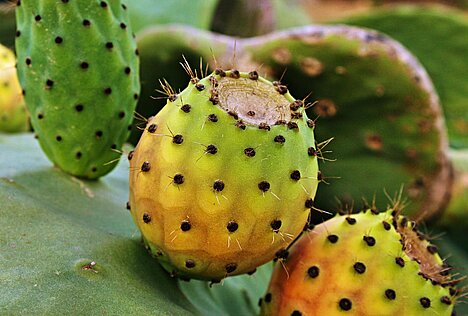Prickly pear

But is prickly pear also suitable for dogs? Can you give your four-legged friend this fruit as a snack or as a supplement to their food? In this article, you'll find out everything you need to know about prickly pear in relation to dogs.
The benefits of prickly pear for dogs
Prickly pear has many positive properties that can also be beneficial for dogs. On the one hand, it is rich in vitamins, minerals and antioxidants, which can strengthen the immune system and protect against free radicals. Secondly, it contains a lot of water and fiber, which can aid digestion and regulate fluid balance. It also has a low calorie content and can therefore help with weight control.
Another benefit of prickly pear is that it can have an anti-inflammatory effect. This can be helpful for skin problems, joint complaints or bladder infections. It can also lower blood sugar levels and thus prevent or alleviate diabetes.
The disadvantages of prickly pear for dogs
Despite its many benefits, prickly pear also has some disadvantages that you should be aware of before giving it to your dog. On the one hand, it can trigger allergic reactions, which can manifest as a skin rash, itching or breathing difficulties. Secondly, it can lead to diarrhea or vomiting if fed in too large quantities or too frequently. This is because it contains a lot of fructose, which is difficult for dogs to digest.
Another disadvantage of prickly pear is that it is very prickly. The fine spines can easily get stuck in the dog's skin or mouth and cause pain or infection. You should therefore always remove the skin thoroughly and cut the fruit into small pieces before giving it to your dog.
How much prickly pear can a dog eat?
As with all new foods, the same applies to prickly pears: Less is more. To avoid possible intolerances or side effects, you should only offer your dog small amounts and observe how he reacts to them. If no problems occur, you can slowly increase the amount.
As a rule of thumb, a dog should not get more than 10 percent of its daily calorie requirement from fruit and vegetables. This means that a dog weighing 10 kilograms can eat about 30 grams of prickly pear per day. This corresponds to about half a fruit.
Prickly pear is a delicious and healthy fruit that can also be suitable for dogs. It has many benefits for the dog's immune system, digestion and metabolism. However, it should only be fed in moderation and attention should be paid to possible disadvantages such as allergies, diarrhea or thorns. If you keep these points in mind, you can treat your dog to a prickly pear as a special reward from time to time.
If you notice any signs of hypersensitivity or poisoning in your dog, you should see your vet immediately. We are not a substitute for a vet, but we try to be as accurate as possible. Every dog reacts differently and we recommend you get a second opinion or consult your vet if in doubt.
Stay healthy and take good care of your four-legged friend!😊
Similar to Prickly pear
Dragon fruit comes from various species of cactus, mainly native to South America but also cultivated in other parts of the world. It is known for its bright pink skin and blotchy white flesh...
Guava is a tropical fruit that originates from Central America. It is known for its sweet, sometimes slightly sour taste and its soft, edible skin. Guava is rich in vitamins and nutrients, making it...
Kiwano has a number of positive properties that make it a healthy food supplement for dogs. Firstly, it contains a lot of water (about 90 percent) and fiber, which is good for digestion. Secondly,...
Passiflora edulis is a species within the Passifloraceae family, originally from South America. The plant produces round to oval fruits with a leathery outer skin and a juicy interior that is rich...



